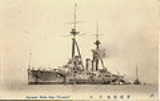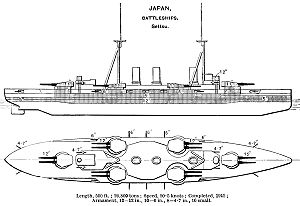
Kawachi class battleship
Encyclopedia
The was a two-ship class
of semi-dreadnought
battleship
s of the Imperial Japanese Navy
. The Kawachi class vessels were the first battleships to be built for Japan exceeding 20,000 tons displacement
, and the last to be built before Japan began building true dreadnoughts.Kawachi and Settsu carried a non-uniform battery of main guns, as they were different lengths—four 50-caliber and eight 45-caliber guns each. The different lengths caused the guns to perform differently, especially at longer ranges. See: Gardiner & Gray, p. 229
, Russia
or the United States
.
 The design of the Kawachi class was a modified version of the previous Satsuma class
The design of the Kawachi class was a modified version of the previous Satsuma class
.
, the Kawachi class carried four Type 41 12-inch (305 mm)/50 caliber naval guns mounted two per turret
; one centerline forward, one centerline aft and eight Type 41 12-inch 45 caliber naval guns mounted in one wing turret on each side that could fire forward and to its side and one wing turret on each side that could fire aft and to its side. These main guns were very unusual in that the centerline guns were longer than the ones in the wing turrets. Although the different calibers were used for budgetary considerations, this had the unexpected benefit of reducing topside weight, and the unexpected demerit of proper gunnery control as the shells from the different length guns had different trajectories.
Secondary armament
was very heavy, as per the previous Aki class design, with ten Type 41 6-inch (152 mm)/40-caliber quick firing guns to counter torpedo boat
attacks.
Tertiary armament consisted of eight Type 41 4.7 inch 40 caliber naval guns and 12 Type 41 3-inch (7.62 cm)/40-caliber naval guns, commonly known as "twelve pounders" plus an additional four Type 41 3-inch (7.62 cm)/25-caliber naval guns
-fired Brown Curtiss turbine engines with 16 Miyabara water tube boilers. The engines produced 25000 shp, yielding a design speed of 20 knots (39 km/h).
Commissioned on 1912-03-31, Kawachi played a minor role in World War I
, and was lost in an accidental explosion with massive loss of life on 1918-07-12.
Commissioned on 1912-07-01, Settsu played a minor role in World War I
. She was disarmed as part of Japan’s compliance with the Washington Naval Agreement in 1924, and used as a radio-controlled target ship thereafter until the end of World War II
.
Ship class
A ship class is a group of ships of a similar design. This is distinct from a ship-type, which might reflect a similarity of tonnage or intended use. For example, the is a nuclear aircraft carrier of the Nimitz class....
of semi-dreadnought
Dreadnought
The dreadnought was the predominant type of 20th-century battleship. The first of the kind, the Royal Navy's had such an impact when launched in 1906 that similar battleships built after her were referred to as "dreadnoughts", and earlier battleships became known as pre-dreadnoughts...
battleship
Battleship
A battleship is a large armored warship with a main battery consisting of heavy caliber guns. Battleships were larger, better armed and armored than cruisers and destroyers. As the largest armed ships in a fleet, battleships were used to attain command of the sea and represented the apex of a...
s of the Imperial Japanese Navy
Imperial Japanese Navy
The Imperial Japanese Navy was the navy of the Empire of Japan from 1869 until 1947, when it was dissolved following Japan's constitutional renunciation of the use of force as a means of settling international disputes...
. The Kawachi class vessels were the first battleships to be built for Japan exceeding 20,000 tons displacement
Displacement (ship)
A ship's displacement is its weight at any given time, generally expressed in metric tons or long tons. The term is often used to mean the ship's weight when it is loaded to its maximum capacity. A number of synonymous terms exist for this maximum weight, such as loaded displacement, full load...
, and the last to be built before Japan began building true dreadnoughts.Kawachi and Settsu carried a non-uniform battery of main guns, as they were different lengths—four 50-caliber and eight 45-caliber guns each. The different lengths caused the guns to perform differently, especially at longer ranges. See: Gardiner & Gray, p. 229
Background
Kawachi and Settsu were ordered under in 1907 Fleet Expansion Program as one of the first steps in full implementation of the Eight-Eight Fleet Program. The Japanese Navy projected that a fleet of eight front-line battleships was the minimum necessary against potential threats from ChinaChina
Chinese civilization may refer to:* China for more general discussion of the country.* Chinese culture* Greater China, the transnational community of ethnic Chinese.* History of China* Sinosphere, the area historically affected by Chinese culture...
, Russia
Russia
Russia or , officially known as both Russia and the Russian Federation , is a country in northern Eurasia. It is a federal semi-presidential republic, comprising 83 federal subjects...
or the United States
United States
The United States of America is a federal constitutional republic comprising fifty states and a federal district...
.
Design

Satsuma class battleship
-External links:*http://homepage2.nifty.com/nishidah/e/stc0117.htm Materials of the Imperial Japanese Navy]*...
.
Armament
For its main batteryMain battery
Generally used only in the terms of naval warfare, the main battery is the primary weapon around which a ship was designed. "Battery" is in itself a common term in the military science of artillery. For example, the United States Navy battleship USS Washington had a main battery of nine guns...
, the Kawachi class carried four Type 41 12-inch (305 mm)/50 caliber naval guns mounted two per turret
Gun turret
A gun turret is a weapon mount that protects the crew or mechanism of a projectile-firing weapon and at the same time lets the weapon be aimed and fired in many directions.The turret is also a rotating weapon platform...
; one centerline forward, one centerline aft and eight Type 41 12-inch 45 caliber naval guns mounted in one wing turret on each side that could fire forward and to its side and one wing turret on each side that could fire aft and to its side. These main guns were very unusual in that the centerline guns were longer than the ones in the wing turrets. Although the different calibers were used for budgetary considerations, this had the unexpected benefit of reducing topside weight, and the unexpected demerit of proper gunnery control as the shells from the different length guns had different trajectories.
Secondary armament
Battleship secondary armament
The secondary armament of a capital ship are smaller, faster-firing weapons that are typically effective at a shorter range than the main weapons...
was very heavy, as per the previous Aki class design, with ten Type 41 6-inch (152 mm)/40-caliber quick firing guns to counter torpedo boat
Torpedo boat
A torpedo boat is a relatively small and fast naval vessel designed to carry torpedoes into battle. The first designs rammed enemy ships with explosive spar torpedoes, and later designs launched self-propelled Whitehead torpedoes. They were created to counter battleships and other large, slow and...
attacks.
Tertiary armament consisted of eight Type 41 4.7 inch 40 caliber naval guns and 12 Type 41 3-inch (7.62 cm)/40-caliber naval guns, commonly known as "twelve pounders" plus an additional four Type 41 3-inch (7.62 cm)/25-caliber naval guns
Propulsion
The engines on the Kawachi class vessels were coalCoal
Coal is a combustible black or brownish-black sedimentary rock usually occurring in rock strata in layers or veins called coal beds or coal seams. The harder forms, such as anthracite coal, can be regarded as metamorphic rock because of later exposure to elevated temperature and pressure...
-fired Brown Curtiss turbine engines with 16 Miyabara water tube boilers. The engines produced 25000 shp, yielding a design speed of 20 knots (39 km/h).
Ships in class
- KawachiJapanese battleship KawachiThe was the lead ship of the two-ship Kawachi-class of semi-dreadnought battleships of the Imperial Japanese Navy. She was built at Yokosuka Naval Arsenal and launched in 1910...
Commissioned on 1912-03-31, Kawachi played a minor role in World War I
World War I
World War I , which was predominantly called the World War or the Great War from its occurrence until 1939, and the First World War or World War I thereafter, was a major war centred in Europe that began on 28 July 1914 and lasted until 11 November 1918...
, and was lost in an accidental explosion with massive loss of life on 1918-07-12.
- SettsuJapanese battleship SettsuThe was the second of the two-ship Kawachi-class of dreadnought battleships of the Imperial Japanese Navy. She was built at Kure Naval Arsenal and launched in 1910...
Commissioned on 1912-07-01, Settsu played a minor role in World War I
World War I
World War I , which was predominantly called the World War or the Great War from its occurrence until 1939, and the First World War or World War I thereafter, was a major war centred in Europe that began on 28 July 1914 and lasted until 11 November 1918...
. She was disarmed as part of Japan’s compliance with the Washington Naval Agreement in 1924, and used as a radio-controlled target ship thereafter until the end of World War II
World War II
World War II, or the Second World War , was a global conflict lasting from 1939 to 1945, involving most of the world's nations—including all of the great powers—eventually forming two opposing military alliances: the Allies and the Axis...
.

